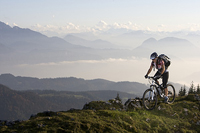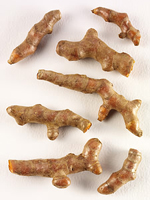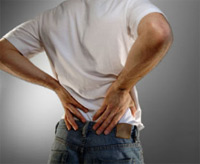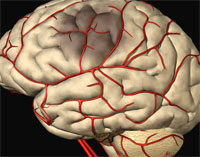Mountain tourism - a pleasant and useful occupation. But here you need to know the measure. Excessive passion for height or non-compliance with the established rules can deliver «Pitmen» Mass trouble. Up to the brain edema.
Content
 When lifting the height of the organs and tissues of the body of a person, a smaller amount of oxygen is obtained than under normal conditions. The body begins to mobilize its protective forces to protect himself from oxygen starvation. Pulse is expected, respiratory rhythm is accelerated, changes in the chemical composition of blood occur. All this allows the body to somehow adapt to the changed conditions of the external environment and transfer more oxygen to organs.
When lifting the height of the organs and tissues of the body of a person, a smaller amount of oxygen is obtained than under normal conditions. The body begins to mobilize its protective forces to protect himself from oxygen starvation. Pulse is expected, respiratory rhythm is accelerated, changes in the chemical composition of blood occur. All this allows the body to somehow adapt to the changed conditions of the external environment and transfer more oxygen to organs.But with an increase in the height, the body's protective forces weaken and cannot restore sufficient for nutrition of tissue oxygen stock. Oxygen fasting of all organs and systems. In tissue cells begins to accumulate liquid. When the liquid accumulates in the brain tissues, the state is developing, which received the name of the high-mountain brain edema. This condition is dangerous for life and, unfortunately, it is often observed in a mountainous disease.
Depending on the training and endurance of the body, the mountain disease may have different severity - from easy to severe. If the rise in the height occurred very quickly and without appropriate acclimatization, the first symptoms of the disease appear after a few hours. With a mild of the disease, patients complain about:
- insomnia, bizarre dreams, frequent awakening at night;
- shortness of breath or difficulty breathing;
- apathy, lethargy of thinking, forgetfulness and light violations of consciousness;
- The condition similar to the face of the hangover: nausea, vomiting, headache, loss of appetite.
If the measures are not accepted and the rise in the height continues, the patient's condition deteriorates sharply. Muscle weakness, drowsiness, perisage of consciousness, hallucinations arise, view disorders. Shortness of breath enhances whetherrs appear in chest and cough. Finally, the patient loses consciousness, comatose and death occurs.
Almost brain swelling develops for several hours, especially with the underestimation of early symptoms. The probability of developing brain edema also depends on the pace of climbing and the height achieved. When lifting the height of over 4000-5000 m, the frequency of this form of the disease is about 1%.
With the slightest signs of a man's starting edema, a person needs to pull down, the delay can lead to the death of the patient, and whenever possible give oxygen (at a speed of 2-4 l per minute). To reduce symptoms and facilitate the state of the victim, it is necessary to introduce intramuscularly dexamethasone (or to give it inside, if the patient's condition is allowed) in the initial dose of 8 mg (2 ampoules or 16 tab.), then every 6 hours giving 4 mg (1 ampoule or 8 table.).
Currently, dexamethasone is the most efficient drug for the treatment of high-rise brain edema. I would like to warn from using Furosemide (Lazix) in this situation. It does not reduce the brain swelling none in hypoxia, nor during crank-brain injury, and therefore its use in these situations is not recommended.
And remember - the disappearance of symptoms does not occur immediately after the descent, so the patient must be transferred under the supervision of medical workers.
Very important point is addictive to height. If you are going to rise to a big height, it needs to be done gradually. After certain intervals, it is necessary to stay and relax, letting it be possible to get used to the organism to get used to the conditions of oxygen starvation. Rest should be long - 2-3 days, then climbing or climbing to height can be continued.
One more condition must perform every traveler rising high in the mountains. If you spend some time at an altitude of 2000-3000 meters (skiing, walk), then you need to go down at night for 500-600 meters below. Then the enemy of the brain does not threaten.
Useful advice: Every climber or traveler, being in the mountains, should follow the state of his health and when the first signs of mountain illness appear to go down immediately.
 First of all, you should not fall into panic when the first signs of mining disease appear. Light symptoms (insomnia, headache) harmless if it takes the necessary precautions on time. Stop climb, stop and unwind 2-3 days at that height you stopped. If you go down for a holiday for 300-400 meters below, your condition will improve much faster.
First of all, you should not fall into panic when the first signs of mining disease appear. Light symptoms (insomnia, headache) harmless if it takes the necessary precautions on time. Stop climb, stop and unwind 2-3 days at that height you stopped. If you go down for a holiday for 300-400 meters below, your condition will improve much faster.
If there are more serious symptoms of mountain sickness (brain swelling), then you must stop moving and be in warm. At the first opportunity, it is necessary to go down below 400-500 meters.
If the patient is in an unconscious state and can not do this, then it must be lower on the stretcher. You can never leave a person one if he had symptoms of high-mountain brain edema. The more impossible to allow him to go down on his own.
Patients are recommended to dramatically limit salt consumption (swelling decreases), and if there is oxygen in the group, then to give a patient from time to time to breathe clean oxygen. Doctors in these cases recommend giving patients with painful, soothing agents and hormonal drugs.
From the funds of traditional medicine, such vegetable drugs like ginger and cayenne peppers are good effect. They stimulate the processes of respiration and metabolism, therefore, indispensable in the supercooling and mining disease.
Ginger is used for receiving inside (20-25 drops of tincture on 100 ml of water), and externally, for rubbing. You can brew tea from the dried ginger root (1/2 teaspoon of the root powder for 200 ml of boiling water. Insist for 20 minutes).
Cayenne pepper in the countries of the East is considered «Crisis herb» and applies in cases where it is necessary to have a warming or stimulating effect. To obtain an immediate effect of 1/2 teaspoon, the cayenne pepper powder is poured in 100 ml of water and drink a volley. It activates the blood circulation, the work of the heart and lungs, to help thus overcome the phenomena of oxygen starvation and reduce swelling.
But remember: it is not recommended to use Cayenne pepper in case the mountain disease is accompanied by hypothermia (supercooling).









